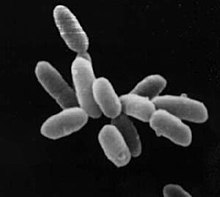Haloarchaea (halophilic archaea, halophilic archaebacteria, halobacteria)[1] are a class of the Euryarchaeota,[2] found in water saturated or nearly saturated with salt. Halobacteria are now recognized as archaea, rather than bacteria and are one of the largest groups. The name 'halobacteria' was assigned to this group of organisms before the existence of the domain Archaeawas realized, and while valid according to taxonomic rules, should be updated.[3] Halophilic archaea are generally referred to as haloarchaea to distinguish them from halophilic bacteria.
These microorganisms are members of the halophile community, in that they require high salt concentrations to grow, with most species requiring more than 2.0M NaCl for growth and survival.[4] They are a distinct evolutionary branch of the Archaeadistinguished by the possession of ether-linked lipids and the absence of murein in their cell walls.
Haloarchaea can grow aerobically or anaerobically. Parts of the membranes of haloarchaea are purplish in color,[5] and large blooms of haloarchaea appear reddish, from the pigment bacteriorhodopsin, related to the retinal pigment rhodopsin, which it uses to transform light energy into chemical energy by a process unrelated to chlorophyll-based photosynthesis.
Haloarchaea have a potential to solubilize phosphorus. Phosphorus-solubilizing halophilic archaea may well play a role in P (phosphorus) nutrition to vegetation growing in hypersaline soils. Haloarchaea may also have applications as inoculants for crops growing in hypersaline regions.[6]
| Haloarchaea | |
|---|---|
 | |
| Halobacterium sp. strain NRC-1, each cell about 5 µm in length. | |
| Scientific classification | |
| Domain: | |
| Kingdom: | |
| Phylum: | |
| Class: | Halobacteria Grant et al. 2002 |
| Order | |
| Synonyms | |
| |
https://en.wikipedia.org/wiki/Haloarchaea
Lil' Deucedeuce Dr. Monster : The Leperchaun | Animated St. Patrick's Day Song | LilDeuceDeuce
No comments:
Post a Comment